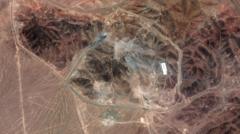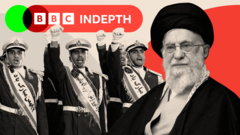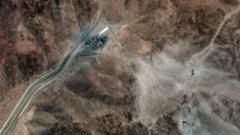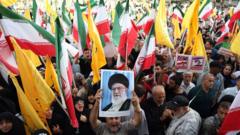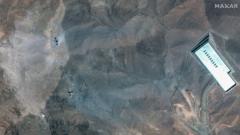**Senior Hamas officials signal heightened attempts to establish a ceasefire while both sides face mounting casualties and humanitarian crises.**
**Mediators Boost Ceasefire Efforts in Gaza Amid Ongoing Violence, Reports Say**

**Mediators Boost Ceasefire Efforts in Gaza Amid Ongoing Violence, Reports Say**
**Intensified negotiations unfold, yet progress remains elusive as conflict intensifies.**
In a renewed wave of violence, a senior Hamas official reported that mediators have stepped up their efforts to forge a new ceasefire deal in Gaza, although talks with Israel remain stagnant. This development follows U.S. President Donald Trump’s statement about "great progress" in the situation since the recent cessation of hostilities between Israel and Iran. Trump indicated that his envoy, Steve Witkoff, expressed optimism about an imminent agreement between Israel and Hamas.
On Wednesday alone, at least 45 Palestinians reportedly died due to Israeli air strikes, many of whom were seeking humanitarian aid, according to the Hamas-run health ministry. Conversely, the Israeli military claimed that seven of its soldiers were killed by a bomb attack attributed to Hamas.
Specifically addressing the situation, President Trump noted the impact of U.S. air strikes against Iranian nuclear facilities over the weekend on the peace negotiations. “I think we’re going to have some very good news,” he shared with reporters in Brussels, claiming that progress is being made. However, a senior Hamas official stated that despite intensified mediation, no new proposals have been submitted.
The negotiations were previously stalled in May when Hamas rejected changes to a U.S.-backed proposal for a 60-day truce, which included the conditional release of hostages. Israel resumed its military operations in Gaza on March 18, following the collapse of a two-month ceasefire aimed at pressure on Hamas for the release of remaining hostages.
Currently, Israel has instituted a complete blockade on humanitarian aid to Gaza since March, partially easing restrictions amid international pressures. Reports reveal that a new aid program, overseen by the Gaza Humanitarian Foundation (GHF), claims to have distributed millions of meals since its operation began in late May, though it faces criticism from UN and other agencies for alleged collaboration with Israeli objectives.
The GHF's distribution efforts have led to thousands of casualties as Palestinians flock to food aid sites often located near Israeli military zones; reports indicate substantial loss of life as individuals sought assistance. Some local observers lament that those aid points have transformed into "death points," as echoed by eyewitness accounts and civil defense reports.
As tensions persist, both sides grapple with loss and humanitarian challenges. In Gaza, reports state that over 549 individuals have died while attempting to obtain aid since GHF's initiated distribution. Meanwhile, Israeli military losses have resurrected plea from coalition leaders for a ceasefire, heightening pressure on Prime Minister Netanyahu amid ongoing operations believed to be in retaliation to a prior Hamas attack that resulted in significant Israeli casualties.
Though some in Gaza harbor hope that the weakening of Iran will lead to a potential truce, others fear that if fighting subsides, Israel might double down on military operations. A grim reality looms in the region as both sides await clearer pathways to peace amidst the ongoing humanitarian crisis, exacerbated by chaotic conditions on the ground.
On Wednesday alone, at least 45 Palestinians reportedly died due to Israeli air strikes, many of whom were seeking humanitarian aid, according to the Hamas-run health ministry. Conversely, the Israeli military claimed that seven of its soldiers were killed by a bomb attack attributed to Hamas.
Specifically addressing the situation, President Trump noted the impact of U.S. air strikes against Iranian nuclear facilities over the weekend on the peace negotiations. “I think we’re going to have some very good news,” he shared with reporters in Brussels, claiming that progress is being made. However, a senior Hamas official stated that despite intensified mediation, no new proposals have been submitted.
The negotiations were previously stalled in May when Hamas rejected changes to a U.S.-backed proposal for a 60-day truce, which included the conditional release of hostages. Israel resumed its military operations in Gaza on March 18, following the collapse of a two-month ceasefire aimed at pressure on Hamas for the release of remaining hostages.
Currently, Israel has instituted a complete blockade on humanitarian aid to Gaza since March, partially easing restrictions amid international pressures. Reports reveal that a new aid program, overseen by the Gaza Humanitarian Foundation (GHF), claims to have distributed millions of meals since its operation began in late May, though it faces criticism from UN and other agencies for alleged collaboration with Israeli objectives.
The GHF's distribution efforts have led to thousands of casualties as Palestinians flock to food aid sites often located near Israeli military zones; reports indicate substantial loss of life as individuals sought assistance. Some local observers lament that those aid points have transformed into "death points," as echoed by eyewitness accounts and civil defense reports.
As tensions persist, both sides grapple with loss and humanitarian challenges. In Gaza, reports state that over 549 individuals have died while attempting to obtain aid since GHF's initiated distribution. Meanwhile, Israeli military losses have resurrected plea from coalition leaders for a ceasefire, heightening pressure on Prime Minister Netanyahu amid ongoing operations believed to be in retaliation to a prior Hamas attack that resulted in significant Israeli casualties.
Though some in Gaza harbor hope that the weakening of Iran will lead to a potential truce, others fear that if fighting subsides, Israel might double down on military operations. A grim reality looms in the region as both sides await clearer pathways to peace amidst the ongoing humanitarian crisis, exacerbated by chaotic conditions on the ground.


